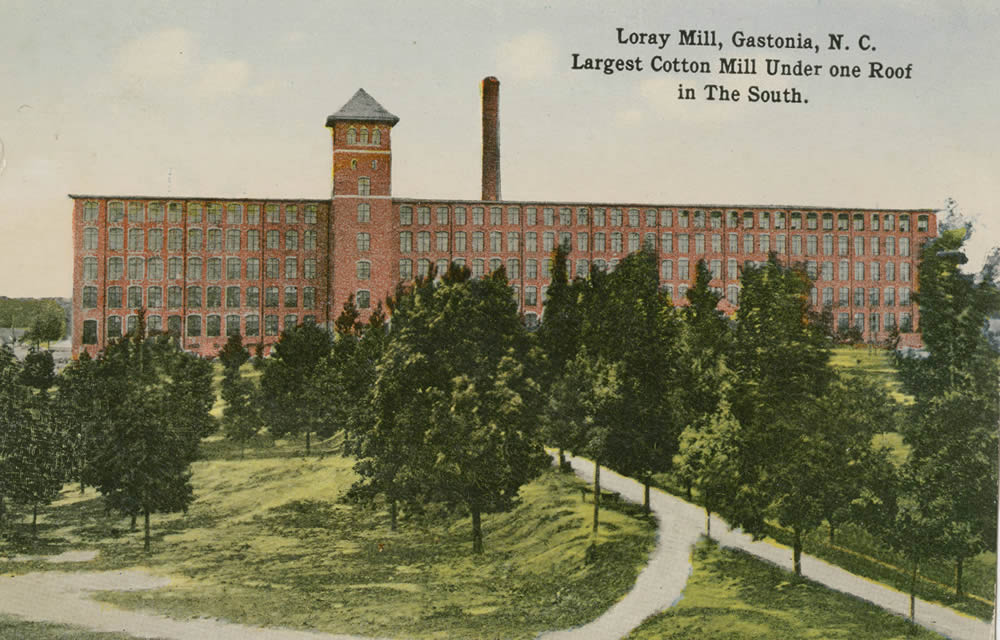The Loray History Center has been in the plans for the mill’s restoration even before the developers were found. Preservation North Carolina (PNC), the rescuers of the mill [JD1], knew two important things about the success of the project. First, because of the mill’s size, it had to be a mixed use project. An earlier attempt from a developer with all rental units had not proceeded. PNC knew that only housing would not have as positive an impact on the surrounding area.
 Second, the project needed somehow to tell the mill’s history. The present development team [JD2] also saw the value of this powerful Loray and Firestone story. They set aside, in the heart of the structure’s first floor, space under the brick archways. Rick Kessell donated funds to Preservation North Carolina to develop the space into a history center in memory of his father, Alfred C. “Freddie” Kessell, who worked in the mill for Firestone for 37 years.
Second, the project needed somehow to tell the mill’s history. The present development team [JD2] also saw the value of this powerful Loray and Firestone story. They set aside, in the heart of the structure’s first floor, space under the brick archways. Rick Kessell donated funds to Preservation North Carolina to develop the space into a history center in memory of his father, Alfred C. “Freddie” Kessell, who worked in the mill for Firestone for 37 years.
Early in the planning process, Dr. Robert Allen of UNC Chapel Hill became involved. Allen had contributed to a program and exhibit in Gastonia in 2008 called “Standing On A Box”. It focused on child mill labor in 1908, especially in Gaston County, as photographed by Lewis Hine. Allen is a Gastonia native who is James Logan Godfrey Distinguished Professor of American Studies and Director of the Digital Innovation Lab (DIL) at UNC Chapel Hill.
Under Allen’s direction, a team of UNC staff and students in the DIL launched the “Digital Loray” project. They conducted research on the Loray/Firestone mill and village and located relevant historical materials, including photographs, newspaper articles, oral histories, and other documents. Working with the North Carolina Digital Heritage Center and the Gaston County Museum, they got these materials digitized and worked to create interactive digital resources for people to engage with them. “Digital Loray” now includes an online archive of over 1200 materials; an interactive map of the mill village in 1920; multi-media timelines; and a public website. Explore the project at: http://www.loraydigital.org.
In September 2014, Allen hired public historian Julie Davis to manage the Digital Loray project and work as the “historian in residence” at the Loray Mill; she also lives in an apartment in the renovated building. Davis has a Ph.D. in American history and a wide-ranging professional background that includes experience working in museums, interpreting historic sites, and conducting oral history projects, as well as teaching, researching, and writing. Previously she worked on the exhibit development team for the Mill City Museum, a historical site located in a former flour mill in Minneapolis.
Representing UNC, Davis has collaborated with Preservation North Carolina, the Gaston County Museum, the Gaston County Public Library, the mill’s owners, and people in the local community to document, preserve, and interpret the mill’s history, and to develop and implement plans for the History Center. The Center will house an exhibit with interactive digital stations that feature Digital Loray materials and resources, as well as text panels, images, and artifacts. It is a very unusual use of technology in a historic setting. There also are plans for the development of public programs and community events, with the participation of the Gaston County Museum and the Gaston County Public Library.
Before the building restoration began, Lucy Penegar and other local supporters rescued and stored several truckloads of items from the mill. Davis has worked with staff from the Gaston County Museum to process these and other mill-related objects donated by community members into an artifact collection. Some of the artifacts will be included in the History Center exhibit, while others will be displayed elsewhere in the building.
So the Loray History Center is under way! Installation of the exhibit will begin this spring, and be completed during the summer. Preservation North Carolina will have responsibility for operating the Center, in partnership with the mill’s owners. UNC’s Digital Innovation Lab continues to produce and share historical materials and online resources through the Digital Loray project.

